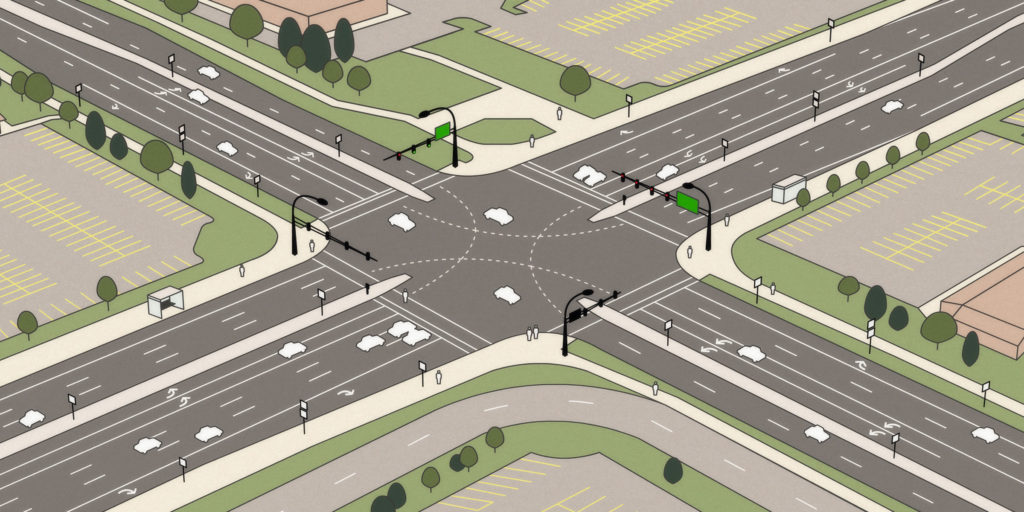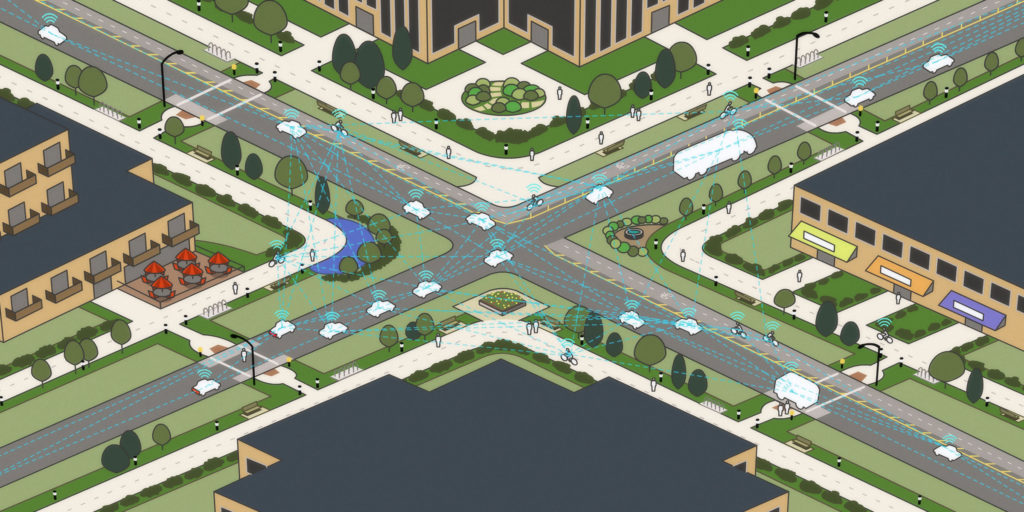Transportation Infrastructure Impacts

A forecast for the year 2020 demonstrates that most of the mobility infrastructure in American cities will remain largely unaltered five years from now, but usage will undoubtedly continue to change (National League of Cities, 2015; AV America, 2018).
Roads Built for Human Drivers

Source: Sohrweide, 2018
Existing roadways and intersections are designed mostly to move human-driven cars and trucks. Timed signals guide cars safely along the corridor, which is designed to accommodate peak congestion hours. There are separate, dedicated turn lanes, each with their own markings. As a result, and in order to accommodate pedestrians, refuge spots exist in the middle of each road for pedestrians who cannot make it completely across in one signal phase. Land surrounding the road is used largely for parking lots, which accommodate drivers visiting area stores and restaurants. At the bottom, there is a frontage road for local access.
Roads Built for AVs

Source: Sohrweide, 2018
In contrast, AVs have the potential to travel more precisely than human-operated vehicles, so they could allow for more narrow traffic lanes, reduce the number of lanes needed to accommodate traffic demand, and remove the need for medians and reduce signage. Roadways in an automated world will be smaller with more efficient right of ways. Details could include the following (Sohrweide, 2018; Lombardo, 2018; Hunt, 2018; ITS International, 2018).
Lane Size: Lanes today are designed to account for driver wander and human error. If lanes were designed to the width of an AV, the lane width could be reduced by 20 percent.
Less Signage: Signs and signals are important features of today’s transportation system as they provide drivers with the information they need to keep the transportation system running smoothly. But with the emergence of V2V and V2I technology, future roadways will not need a large number of traffic signs and signals as information can be transmitted to AVs wirelessly and in real time.
Traffic Reduction: AVs are able to drive more efficiently than humans can so they can ride closer together, reducing traffic and congestion. Since 93 percent of crashes are caused by human error and 25 percent of congestion is caused by traffic incidents, congestion should be reduced even further with AVs.
Drop-Off Lanes: AVs are also expected to reduce the number of vehicles needed by promoting ride-sharing which will create a need for drop-off lane construction. These will be in areas that are as close as possible to the entrances of destinations.
Parking Lot Revolution: Since there will be fewer cars on the roads, there will be massive changes made to the location, form and amount of parking needed as AVs can park themselves and remain in the transportation network while waiting for a passenger.
Pedestrian Crossings: Today, for safety reasons, most pedestrian facilities exist at controlled intersections. However, this can require an average pedestrian to walk extra blocks to get to their destination. Future pedestrian crossings, following AV implementation, would be moved away from the intersection.
Multiple Land Use: With fleets of driverless cars operating like a modern transit system, AVs are likely to pick up and drop off passengers twenty-four hours a day. The land, then, becomes available for any number of uses.
In the future, there could be far fewer road expansion projects and, with less pavement, a decrease in typical roadway maintenance –the result of fewer lights, less pavement, and no pavement markings. Traffic-related signs would exist largely for pedestrians. The cost-savings on the maintenance side, however, would be balanced by the costs of the technology. More funding will be needed to install and support high-tech roadways, which might include digital technology in the pavement, sensored lights and other digital components (Sohrweide, 2018).
